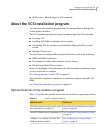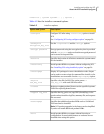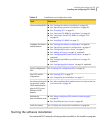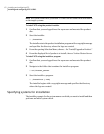
Table 4-3
Installation and configuration tasks
ReferenceTask
■ See “Starting the software installation” on page 61.
■ See “Specifying systems for installation” on page 62.
■ See “Licensing VCS” on page 63.
■ See “Choosing VCS RPMs for installation” on page 64.
■ See “Choosing to install VCS RPMs or configure VCS”
on page 65.
■ See “Installing VCS RPMs” on page 75.
LicenseandinstallVCS
■ See “Starting the software configuration” on page 66.
■ See “Specifying systems for configuration” on page 67.
■ See “Configuring the basic cluster” on page 67.
■ See “Adding VCS users” on page 71. (optional)
■ See “Configuring SMTP email notification” on page 71.
(optional)
■ See “Configuring SNMP trap notification” on page 73.
(optional)
■ See “Configuring global clusters” on page 74. (optional)
Configure the cluster
and its features
See “Creating VCS configuration files” on page 76.Create configuration
files
■ See “Starting VCS” on page 77.
■ See “Completing the installation” on page 77.
Start VCS and its
components
■ See“AboutenablingLDAPauthenticationforclustersthatrun
in secure mode” on page 78.
Forclustersthatrunin
secure mode, enable
LDAP authentication
plug-in if VCS users
belong to LDAP
domain.
■ See “About configuring VCS clusters for data integrity”
on page 87.
■ See “Installing the Java Console” on page 80.
Perform the
post-installationtasks
See “Verifying the cluster after installation” on page 84.Verify the cluster
Starting the software installation
You can installVCS usingthe Veritas product installer orthe installvcsprogram.
61Installing and configuring VCS
Installing and configuring VCS 5.0 RU3


















